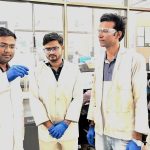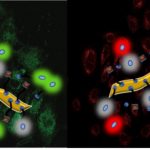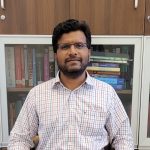Erode N Prabhakaran’s lab designs miniature protein models using organic chemistry to solve problems in biology
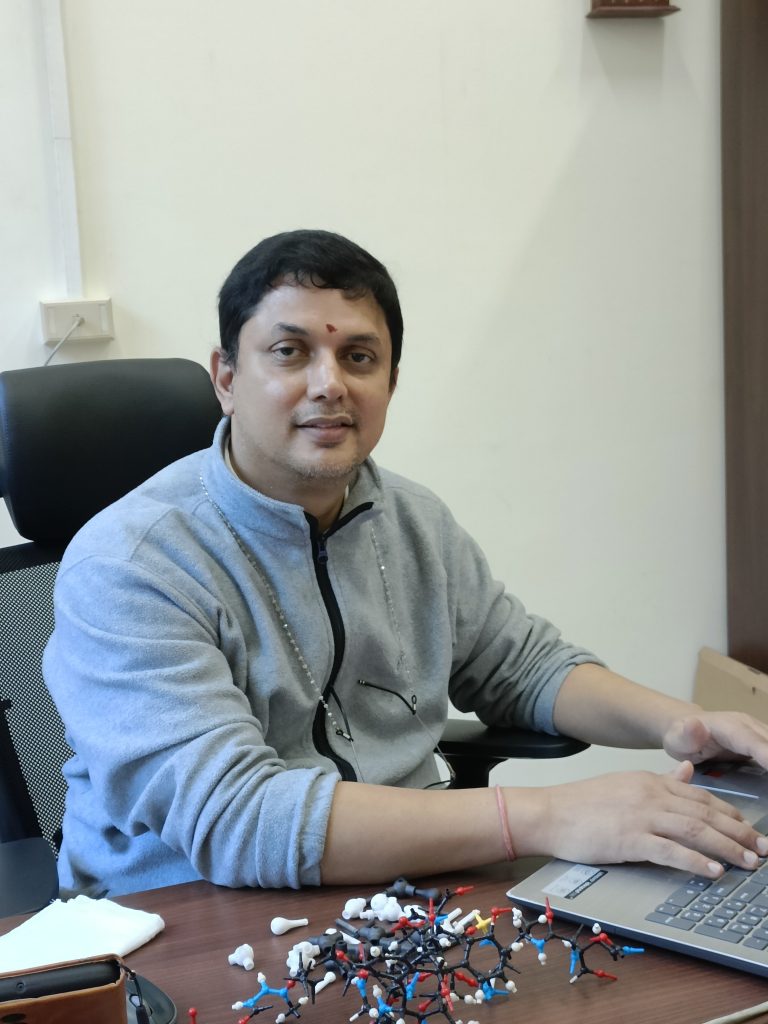
Erode N Prabhakaran had taken a liking to science right from his secondary school days at Gill Adarsh in Chennai. But it was his 11th grade teacher, Kaveri Padmanabhan, whose simple approach to chemistry solidified his interest in the subject. “I went and met her after I became a faculty member here … to thank her,” says Prabhakaran, now an Associate Professor in the Department of Organic Chemistry, IISc.
Prabhakaran’s fascination with chemistry – specifically organic chemistry – continued to grow while pursuing his Master’s degree at the Sri Satya Sai Institute of Higher Learning in Puttaparthi. His role model there was one of his professors, NR Krishnaswamy, whose teaching of chemical transformations and syntheses “was like poetry,” says Prabhakaran. For his Master’s project, Prabhakaran worked on studying the effects of Krishna tulsi extracts on groundnut varieties, and went on to earn a gold medal for his overall excellence in chemistry.
After clearing the CSIR and GATE exams, he was selected to pursue his PhD at IIT Kanpur under the supervision of eminent peptide chemist Javed Iqbal. His research on cobalt catalyst-mediated oxidation reactions, and the synthesis of potential HIV-1 protease inhibitors helped lay a strong foundation for applying synthetic organic principles to target biochemical problems. Following his PhD, he received the Boehringer-Ingelheim post-doctoral fellowship at the Indiana University, Bloomington with Jeffrey Johnston, and later worked as an NIH scientist with Martin Scholtz and Nick Pace at Texas A&M University. There, he was involved in designing the very first microbial RNase – a bacterial enzyme that breaks down RNA – to make it selectively target and kill mammalian cancer cells. “During this period, I got a lot of ideas on how to apply synthetic organic techniques to address problems in protein chemistry,” he says.
After his stint at Texas A&M, Prabhakaran joined IISc in 2006. His group focuses on studying principles of protein structure through peptide folding, which involves building replicas of small protein chains called peptides in the lab, using synthetic organic chemistry. They use these replicas – called peptidomimics – to decipher the structure and function of their natural counterparts, using a variety of spectroscopic, calorimetric and scattering techniques.
Proteins or polypeptides are linear chains held together using peptide bonds, which are largely rigid. “But there are two other bonds along the backbone of any amino acid residue which can twist and wiggle at certain angles to fold the evolved protein chain into a largely compact structure,” Prabhakaran says. Back in 1963, the renowned biophysicist GN Ramachandran showed that these twist angles of individual amino acid residues, when plotted on a graph, can take up only a small fraction of the entire area. This meant that peptides have a limited space within which they can exist in a stable state and cannot exist in certain “disallowed” conformations. “Basically, atoms are like billiards balls – they cannot infringe into each other’s space,” Prabhakaran explains. But questions remained: What are the origins of these disallowed conformations in certain proteins? What are the consequences on a protein that has a residue in a disallowed conformation?
To find out, Prabhakaran and his team designed a miniature replica of an amino acid called alpha-amino isobutyric acid (amino acids are the building blocks of proteins). They induced a disallowed conformation by removing one hydrogen atom from an amide group and making it an oxazine group. This stabilised the amino acid in a disallowed conformation. They studied how this amino acid would behave when placed in different protein folds. They found that even if the protein has an amino acid with disallowed conformation, this need not disrupt the way the protein folds, but the modified amino acid residue creates small structural changes to other residues nearby. “These results have great importance as they provide a way to validate disallowed conformations observed in crystals – by looking for local interactions that stabilise the conformations,” says Prabhakaran.
Similarly, his group has also worked on the structure-activity relationship in N-acyl homoserine lactones, molecules involved in quorum sensing – a type of cell signalling in certain bacteria. By elucidating the structure and mechanism of action of these lactones using analogs, his team determined the most suitable points in the molecular structure that can be targeted for variations, so that they can potentially be used in bactericidal molecules and in tissue engineering.
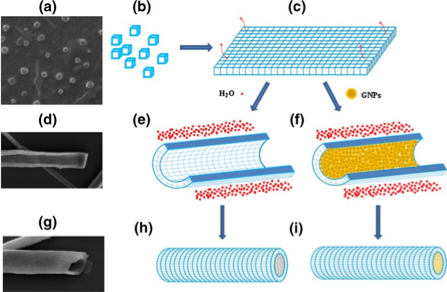
Another area that his lab focuses on is studying the intramolecular forces in cis and trans isomers of peptides – twin forms that have the same number of atoms but look different structurally. The team creates molecules with controlled equilibrium between the cis and trans states, which are essential in drug design, protein and peptide structure manipulation and even for converting biomass to energy. “Our group is among the experts in controlling this equilibrium and shifting it in favour of the elusive cis form, especially in the amino acid proline,” explains Prabhakaran. His group has created stable cis peptides of proline, through a different way compared to previous approaches. While other approaches significantly alter the main ring of proline, Prabhakaran and his team instead changed the spatial arrangement of atoms around the ring, creating a stable cis form. Using the same approach, the group has made accessible several structures that were earlier thought to be inaccessible but are now available in the Cambridge Crystallographic Data Centre (CCDC), the world’s largest database of crystal structures of organic molecules.
The current focus of research in Prabhakaran’s lab is the design and synthesis of highly efficient covalent surrogates for the peptide hydrogen bond, which can substitute the naturally present hydrogen bond in peptides. Using these, the team constructs alpha-helix turn peptide mimics and by extension, lab-scale models of the alpha-helix and beta sheets – core structures that are found in all proteins. They have built mimics of alpha-helix interfaces and proteins implicated in various cancers. They have also built mimics of core domains of the ACE2 protein which binds to the spike protein of SARS-CoV-2. “These are lead molecules that are being modified as potential therapeutics against various cancers, and for design of drugs against COVID-19,” Prabhakaran says. Similarly, their β-sheet templates have helped them make among the first spectroscopic observations of certain configurations (called monomeric configurations) of peptides implicated as causative agents in neurodegenerative disorders like Alzheimer’s, Huntington’s disease and so on. His team has also developed gold microrods for applications in biosensing, nanoelectronics and in fluorescence imaging.
Designing these molecules is challenging, according to Prabhakaran. “To create a model peptide, you need to start tinkering with each of its structural aspects … you chemically tie a knot somewhere, you pull a bond somewhere, you create a strong click connection somewhere.”
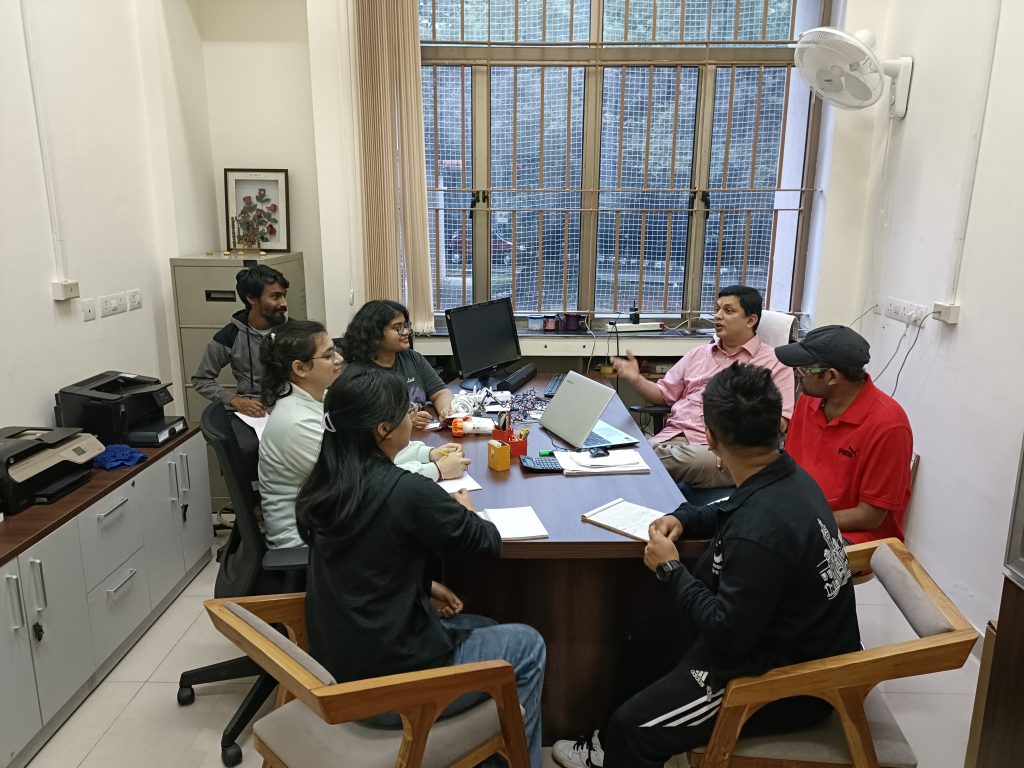
Prabhakaran is an early riser, usually up by around 3.30 am. A typical day starts with analysing data shared by his students the day before and passing on suggestions for further experiments.
Prabhakaran also makes it a point to meet with his students regularly and enjoys discussing with them about the data analysis and results, he says. “There is a tremendous give-and-take from which all of us learn a lot.” Aside from his research, he also juggles the tasks that come with being the Convenor of the Institute NMR Facility (INF), the Sophisticated Analytical Instruments Facility (SAIF) and coordinating the setting up of a helium recovery plant that is upcoming at IISc. He is also a member of the amenities and wellness committees at the Institute. In addition, he has served as a planning committee member from Karnataka involved in formulating India’s New Education Policy.
In his spare time, Prabhakaran pursues diverse hobbies that keep him relaxed, like reciting and teaching Vedas and scriptures, playing the mridangam, composing music and sketching – he points to a pencil sketch he made of a crouching lioness hanging behind his desk – in line with his belief that “resting is rusting.”

